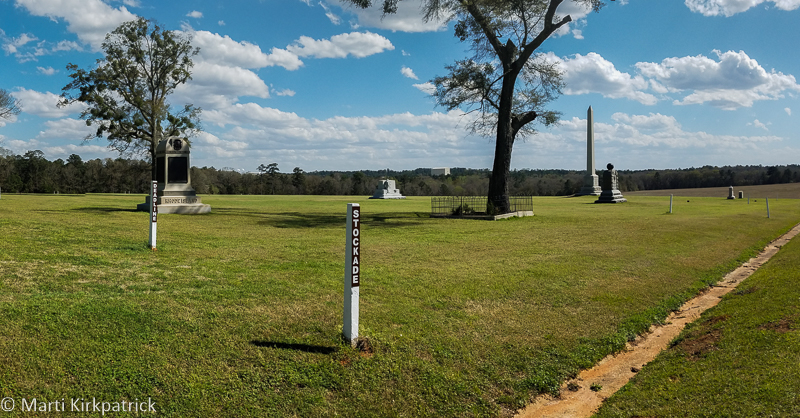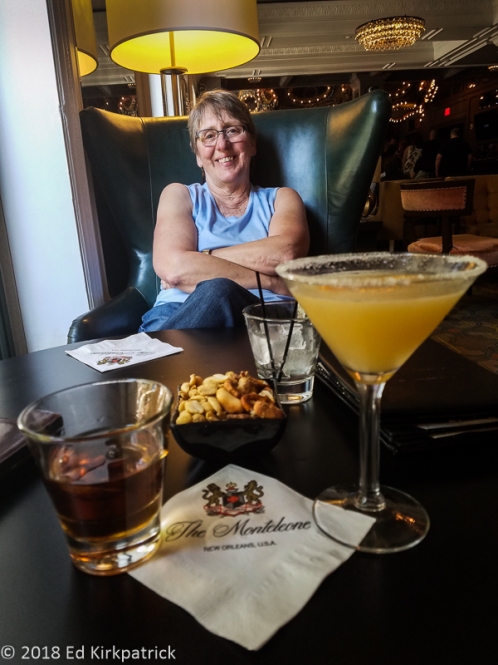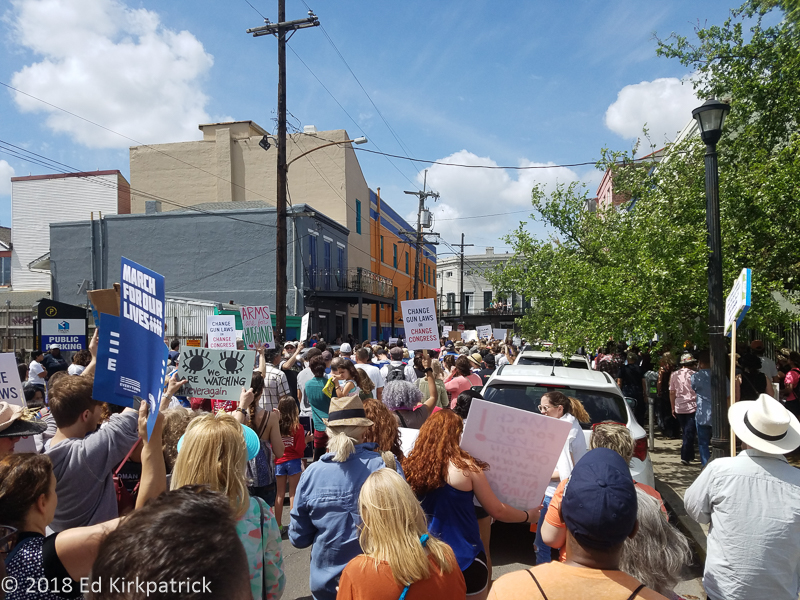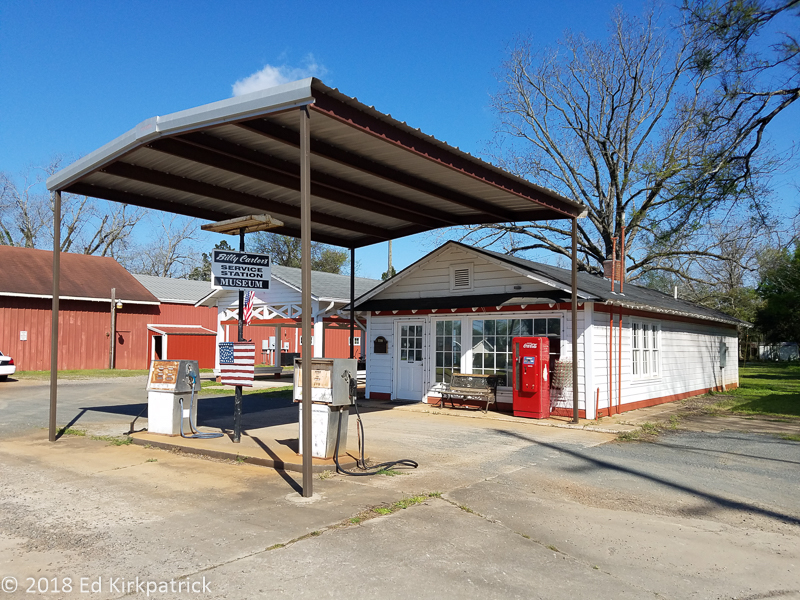Tags
Andersonville, Georgia, Grand Isle, Houmas House, National Prisoner of War Museum, New Orleans, RV Travels, Selma Alabama, Voting Rights Act
Hi guys, remember us?!!
With the exception of a quick run to Texas in December, and a quick run to Sarasota the beginning of March, Ed and I were “home” in Dickerson, Maryland all of Fall, Winter into mid-March! Once again we are grateful to our dear friend Carolyn Mackintosh (and Bob 🙂 ) for our stay at Loch Moy Farm, home of the Maryland Horse Trials and our 2 month house/dog sitting gig for friends Chet & Paula and doggie Sammy. It is always wonderful to be back with our many friends and family but we are soooooo happy to finally be back on the road again.
With the cold weather still a factor we headed directly south with our first planned tourist stop being Andersonville, GA., where we stayed at the Andersonville RV Park, which is “adequate”.

The tiny town of Andersonville, Georgia is home to a very small, very good Drummer Boy Civil War Museum in the back of the tourist visitor center/RV Park check-in. When we were there it was staffed by half Cherokee, half Cajun Cynthia Stormchaser who was a font of information and delightful to chat with.
You Civil War buffs will recall that the Andersonville POW camp was/is the most infamous of all the camps both South and North. Neither side was prepared, nor expected, to have to hold the thousands of enemy prisoners resulting from a war which lasted far longer than predicted. The overcrowding, bad sanitation, lack of medicine and inadequate food & clothing led to disease, starvation and exposure and took thousands of lives. The POW death rate records suggest 15% of Union and 12% of Confederate POWs did not survive the camps.

The two posts shown here are two of many that mark the perimeter of the camp. The post labeled Stockade is the actual wall location of the 15 ft. high stockade and the post 19 ft. further back was the “Deadline”. A simple post and rail fence this boundary marked a line past which if any part of a prisoner’s body crossed for any reason he would be shot.

Nineteen year old prisoner Dorence Atwater worked in the hospital where he recorded names and grave locations of the deceased. He secretly copied this list and smuggled it out when released. After the war, he asked the War Department to publish the list. They refused. He and Clara Barton returned to Andersonville and with his list, they were able to mark the graves of many of the dead.

Andersonville Camp is now the location of the National Prisoner of War Museum which is in desperate need of better display lighting but otherwise interesting.
Continuing on with our look at Southern history we headed down Rt. 49 to State Route 280 and Plains, Georgia, home of perhaps our kindest President, James Earl Carter Jr., where we saw Jimmy this and Jimmy that, but not Jimmy himself 🙂 . Oh well, the peanut butter soft serve was yummy!

Jimmy Carter’s Presidential Campaign Headquarters in Plains, Georgia. Marti voted for him. Me, well…
As usual for us, we traveled the secondary roads which were very busy with logging trucks (thankfully going the opposite direction). We are accustomed to seeing them in places like most of non-coastal Maine and the Pacific Northwest but it was an impressive reminder of how much southern yellow pine is cut in this part of the country.
I purposely routed us towards Montgomery, AL in time for a late lunch at Dreamland BarBQ where we once again enjoyed delicious ribs before settling in for the night at lovely, quiet Gunter Hill COE campground where with our American Senior Pass $9 was our fee!
Next up on our history tour was Selma. After parking, our first stop was the National Park Service’s Selma Interpretive Center at the corner of Broad Street and Water Avenue just before the Edmund Pettus Bridge over the Alabama River. On the first floor, there is an excellent photographic timeline illustrating the fight to win the most basic of civil rights denied African Americans at the time. The story leading up to and through Bloody Sunday, March 7th, 1965 and culminating with the March 21st start of the 54-mile walk from Selma to Montgomery, 4,000 marchers demanding voting rights for all African Americans, headed over the bridge named for a Confederate General and Grand Dragon of the Alabama Ku Klux Klan. When the road, Jefferson Davis Highway narrowed to two lanes they were restricted to 300 people but by the time the marchers arrived at the Alabama State Capital in Montgomery on March 25th, they were 25,000 strong.

Looking back towards Selma from the Edmund Pettus Bridge.
On the third floor of this center, there is a short film largely narrated by participants in the historic march. There are also a few comments offered by folks with a different view on the events leading up to and during the Selma to Montgomery March. We strongly encourage all of you to put at least a visit here and a viewing of this film on you MVL (Must Visit List).

On the second floor of the Selma Interpretive Center, this display invites you to take a stand with the marchers.
After a brief visit to NOLA (New Orleans) to see our friend Michael Verderosa (if you’re interested in real estate here Michael is your man!) and to enjoy a libation or two (Sidecars and Woodford Reserve at the Carousel Bar in Hotel Monteleone YUM!!!!)

A very civilized afternoon.
AND to participate in New Orleans’ March For Our Lives protest,

Fulfilling what we believe is our civic duty. This is what Democracy looks like!
we drove down 308 south to Grand Isle, a finger of land into the Gulf of Mexico where we stayed at the very end in Grand Isle State Park. Although the drive across the Gateway to the Gulf Expressway, a 19-mile elevated toll road from Golden Meadow to the Gulf of Mexico almost all over water is impressive, we do not recommend this visit unless you like fishing. The water here is rough, brown (stirred up sand) and not interesting to us, but we do understand the fishing out in the Gulf here is some of the best there is.
Our next campground was at Poche Plantation & RV Park along “the River Road” Rt. 44, known for the many Mississippi River Plantations located here. NOTE fellow RV’ers…..Poche Plantation is basically just a $40 place to park for the night….to our thinking there’s no charm and the house, unfortunately, is NOT open for viewing.

Clearly, it would be a charming house to look at if it was open…
That being said, it is just 12.6 miles from Houmas House Plantation and Gardens. Ed & I have been to many of the plantations in this general area on both sides of the Mississippi. We think without question Houmas House is the most impressive in large part due to the gorgeous gardens and the civility of having access to the excellent Turtle Bar where for a reasonable price Ed enjoyed a healthy glass of Eagle Rare Bourbon as we meandered around the grounds.

Houmas House. This pond is fairly new. It was created after one of the centuries old magnificant Live Oaks toppled over one night last year and left a crater.
Named after the Houma Indians the main house was completed in 1840. A working sugar plantation as early as 1803, the 10,000 acres were purchased in 1857 for $1,000,000 ($26.5 million in today’s money) by Irishman John Burnside who increased his holdings to 12,000 acres. Consisting of several additional surrounding plantations all worked by approximately 750 slaves, the property had four sugar mills and rail lines to haul the cane product over Burnside’s vast holdings! While we think the story at Laura Plantation is by far the best, and the live oaks of Oak Alley are truly magnificent do put Houmas House on your MVL. Oh, and while the service at the Café Burnside (one of several restaurants on the grounds) is lousy, the food was pretty good.

Once a free-standing staircase, the back wall was added by a former owner to make a smaller room.

The centuries old Burnside Oak frames the plantation house at Houmas. Marti says that personally, the best thing about the South is the lovely huge Live Oaks.
Working our way west, we are currently in Texas having just finished a visit with our daughter-in-law in Leander and our “adopted” kids in Bastrop. We hope to do better at keeping you all up to date on our travels with lots of Ed’s wonderful photographs and my wandering comments and observations. Hope you’ll want to follow along and forgive us if we lag behind our physical location 🙂
Until next time…..stay safe, happy and remember….Life’s An Adventure!!

At the Drummer Boy Museum, Mary Surratt’s bonnet which was removed from her head moments before she was hung for her role in Lincoln’s assassination conspiracy.

The dark lines at the base of these hills are the very small creeks which flowed through the camp and were the only and inadequate source of fresh water for the prisoners. Unfortunately, upstream was where the guard’s and officer’s latrine was located.

The prisoners prayed for fresh water from anywhere and a bolt of lightning struck the ground and a spring welled up. This monument marks the approximate spot of their prayers being answered so they named it Providence Spring.

Billy Carter’s Service Station Museum in Plains, Georgia. Ed could not find any Billy Beer though.

In New Orleans, in the French Quarter on Royal Street, we discovered and toured the Gallier House. This wonderful home stands as it was built and decorated and is really lovely.

For our son Kevin’s Birthday present?

Fort Jackson is a masonry fort built as a coastal defense for New Orleans between 1822 and 1832. 40 miles upstream from the mouth of the Mississippi it was ruined by hurricanes Katrina and Rita and its condition is threatened. There was a battle here in the Civil War as Admiral Farragut sailed up the river to take the city.

On Grand Isle, most houses are on stilts and some trailers are really fastened down.

Street poets offer a poem if you give them a subject. Marti asked this one if she could give him the first line instead. He said, “What is it?” to which she replied, “She slipped on her flip-flops, pulled on her hat and headed for the door.”
He thought for a moment, smiled and then started typing…
“perspiring”
she slipped on her flip-flops, pulled on her hat,
and headed for the door,
unneeding of socks or laces like that,
interested instead in what was in store.
she spilled from the threshold and greeted the light
winced with some boldness in a way that just might
be met by the sun as a challenge to spar,
now there on the front step, the door still ajar,
she raised her eyes up as if to say to that god,
“i have never feared you, so let the sweat drip.”
the sun, in response, that fiery pod
said, “alright. well, game’s on.” and left pools in her pits.
jacknorcross,neworleans,la, march,25,2018


Good blog. Happy to be back on the road, I’m sure. Safe travels.
Love,
BooBoo and Mike
LikeLiked by 1 person
So glad Whack-a-Mole wheels is back on the road! I have never heard of Andersonville, Ga but that is such an interesting story!
Love you two,
Bug
LikeLiked by 1 person
Fun stuff. Interesting info on the South.
REX in Iowa
LikeLiked by 1 person
Marvelous! We’ve seen some of the places on this adventure of yours. Having traveled the south when we were involved in CW reenacting. Loved the pic of Mary Surrat’s bonnet! And I’ve never seen a southern plantation I didn’t want to tour. Very emotional seeing Andersonville. So glad we got to spend time “chatterboxing” with you. Have fun on your wanderings. We’ll catch you on the road someday.
LikeLiked by 1 person
It was a wonderful little museum. We’ll keep an eye out for you!!
e
LikeLike
Great post! I agree Houmas House was my favorite. Pooche Plantation was a PPA campground so I don’t know if it still is. That cut the cost by 50% during the week.
Interesting read.
Karen B in RI
LikeLike
Nope, no discount offered….it was raining and the office wasn’t open so who knows
…..??
LikeLike
Hello there,
That was an excellent read and snaps were lovely! Where shall we go next, as I am now traveling vicariously through you? I can’t wait to see and read …. hope all is well with you and of course safe travels.
Cheers Wanda
>
LikeLiked by 1 person
Hey Wanda….we think of your beautiful north country often…..it sure isn’t the US South 🙂
LikeLike
Great blog! Safe travels
LikeLiked by 1 person
Great edition of your fabulous Blog you two, such great collaboration and fascinating stories. I’ve read quite a lot about Andersonville but have not seen current photographs, such a horror that was and so serene now.
LikeLiked by 1 person
Ed, Thanks for this. My great grandfather George Weysser was a prisoner at Andersonville. I have a copy of his deposition and those of witnesses to his describing what he had experienced. He weighed 65 pounds when released from Andersonville in December 1864. He had been captured in June of that year in the engagement at the Jerusalem Plank Road near Petersburg.
He lived till 1906 but had some challenges that we would classify today as PTSD. I was just saying to Rosemary that I want to visit Andersonville, and you have reinforced that desire. Thank you! Regards, Bill Johnson
Sent from my iPad
>
LikeLike
Wow that’s amazing. My Great Grandfather Deppa fought in the Civil War and I think may have been a prisoner at one point, but not Andersonville thank goodness.
LikeLike
Andersonville must have been really sobering. What a terrible place that was!
I would so love to see some of the plantations along the Mississippi again. My father took me to a few of them many years ago and they and their grounds were beautiful.
He also took me to the site of the Battle of New Orleans, but not to the city, itself. I went with one of my nephews, who was traveling with us, but didn’t get to see the city at night. Another place I would love to visit!
Enjoy your travels!
LikeLike
We pretty much always stop in NOLA, it’s an experience 🙂
LikeLike
Very interesting and informative as always….Loved the poem
LikeLiked by 1 person